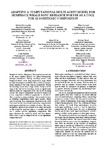Adapting a Computational Multi Agent Model for Humpback Whale Song Research for use as a Tool for Algorithmic Composition
| dc.contributor.author | Miranda, Eduardo | |
| dc.contributor.author | McLoughlin, M | |
| dc.contributor.author | Lamoni, L | |
| dc.contributor.author | Garland, E | |
| dc.contributor.author | Ingram, Simon | |
| dc.contributor.author | Noad, M | |
| dc.contributor.author | Rendell, L | |
| dc.contributor.author | Kirke, Alexis | |
| dc.date.accessioned | 2016-11-28T16:25:27Z | |
| dc.date.available | 2016-11-28T16:25:27Z | |
| dc.date.issued | 2016-08-31 | |
| dc.identifier.isbn | 9783000537004 | |
| dc.identifier.issn | 2518-3672 | |
| dc.identifier.uri | http://hdl.handle.net/10026.1/8036 | |
| dc.description.abstract |
Humpback whales (Megaptera Novaengliae) present one of the most complex displays of cultural transmission amongst non-humans. During breeding seasons, male humpback whales create long, hierarchical songs, which are shared amongst a population. Every male in the population conforms to the same song in a population. During the breeding season these songs slowly change and the song at the end of the breeding season is significantly different from the song heard at the start of the breeding season. The song of a population can also be replaced, if a new song from a different population is introduced. This is known as song revolution. Our research focuses on building computational multi agent models, which seek to recreate these phenomena observed in the wild. Our research relies on methods inspired by computational multi agent models for the evolution of music. This interdisciplinary approach has allowed us to adapt our model so that it may be used not only as a scientific tool, but also a creative tool for algorithmic composition. This paper discusses the model in detail, and then demonstrates how it may be adapted for use as an algorithmic composition tool. | |
| dc.format.extent | 274-280 | |
| dc.language.iso | en | |
| dc.title | Adapting a Computational Multi Agent Model for Humpback Whale Song Research for use as a Tool for Algorithmic Composition | |
| dc.type | conference | |
| dc.type | Conference Proceeding | |
| plymouth.date-start | 2016-08-31 | |
| plymouth.date-finish | 2016-09-03 | |
| plymouth.conference-name | Sound and Music Computing Conference | |
| plymouth.publication-status | Published | |
| plymouth.journal | Proceedings of the Sound and Music Computing Conference | |
| plymouth.organisational-group | /Plymouth | |
| plymouth.organisational-group | /Plymouth/Faculty of Arts, Humanities and Business | |
| plymouth.organisational-group | /Plymouth/Faculty of Science and Engineering | |
| plymouth.organisational-group | /Plymouth/REF 2021 Researchers by UoA | |
| plymouth.organisational-group | /Plymouth/REF 2021 Researchers by UoA/UoA07 Earth Systems and Environmental Sciences | |
| plymouth.organisational-group | /Plymouth/REF 2021 Researchers by UoA/UoA33 Music, Drama, Dance, Performing Arts, Film and Screen Studies | |
| plymouth.organisational-group | /Plymouth/Research Groups | |
| plymouth.organisational-group | /Plymouth/Research Groups/Marine Institute | |
| plymouth.organisational-group | /Plymouth/Users by role | |
| plymouth.organisational-group | /Plymouth/Users by role/Academics | |
| plymouth.organisational-group | /Plymouth/Users by role/Researchers in ResearchFish submission | |
| dc.publisher.place | Hamburg, Germany | |
| dcterms.dateAccepted | 2016-06-20 | |
| dc.rights.embargoperiod | Not known | |
| rioxxterms.licenseref.uri | http://www.rioxx.net/licenses/all-rights-reserved | |
| rioxxterms.licenseref.startdate | 2016-08-31 | |
| rioxxterms.type | Conference Paper/Proceeding/Abstract |


